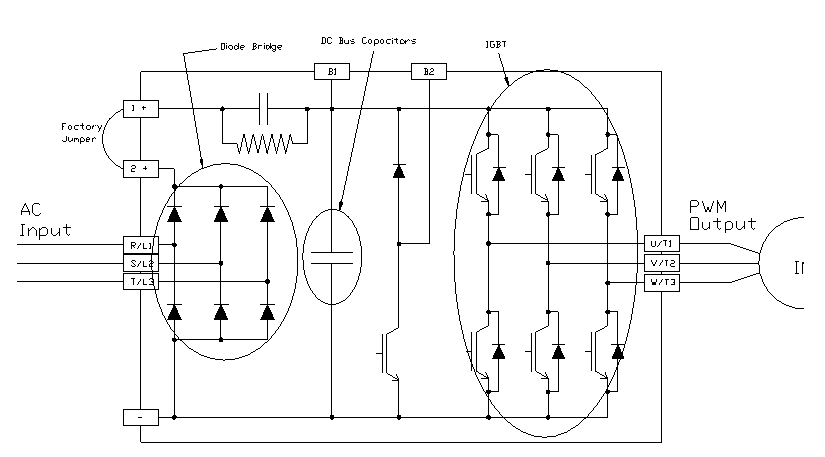Variable frequency drives (VFDs) have been commonly used in industrial and commercial applications for decades. The basic design topology of the VFD with a diode bridge, DC bus capacitors and insulated gate bipolar transistor (IGBT) output has proven to be reliable and beneficial from application and financial perspectives. In general, these applications have been installed on a balanced three-phase power supply, meaning that the impedance line to line is balanced. Therefore, under normal conditions, the voltage and current are balanced phase to phase. While there can be differences relative to ground—which may be done intentionally for single-phase loads such as lighting—the phase-to-phase relationship remains balanced.
In many rural areas, the balanced, three-phase supply is commonly replaced by a grounded, open-wye to center-tapped, grounded, an open-delta configuration. This is done mainly to save on installation costs since the three-phase supply only requires two transformers and two current-carrying conductors. The open-delta configuration is generally suitable for locations at which the majority of the load is single-phase and a relatively small amount of three-phase load exists. End users and installers of rural pumping systems need to be aware that an open-delta supply is feeding their application because unbalanced supplies can cause the overheating of three-phase motors that are run across the line. Installing a VFD in front of the motor will isolate the motor from the imbalance. However, the imbalance is transferred to the VFD. Therefore, when installing VFDs or other three-phase loads on open-delta supplies, proper steps must be followed.

Topology of most common VFDs
If proper precautions are not taken when installing a VFD on an open-delta supply, premature failure of the drive can be expected. Types of VFD failures seen are one or more shorted diodes and/or DC bus capacitor failures. When or if these failures will occur depends on the actual load placed on the VFD and the quality of the power being delivered to the drive. Open-delta systems often exhibit increased voltage fluctuation as single-phase loads are applied and removed from the sometimes unevenly sized transformers. Furthermore, open-delta configurations are often used at the end of the line where high line impedance may further exacerbate voltage fluctuation.
Understanding that the time to premature failure may be quite long, possibly years, is important. A properly installed and sized VFD should be able to run trouble free for several years, and some systems have been running more than a decade. Understanding installation and properly accounting for any variables, such as an open-delta supply, is the best way to maximize a VFD’s run life.
This article examines the results of one field test on an actual open-delta supply. Two key areas will be affected by the installation of a VFD on an open-delta supply:
- The load imbalance’s effect on the VFD’s components
- Mitigation of harmonics produced by the VFD
Identifying an Open-Delta Feed
How do users identify if their power is from an open-delta feed? Most rural pump installations are at the end of a utility wire run and have dedicated transformers feeding them. First, look at the utility pole that holds the transformers supplying the service and identify the current-carrying lines that run to the transformers. Simply count the transformer cans hung on the pole. Generally, a balanced, three-phase system will have three transformer cans, although there are single cans containing all three windings, so noting the current-carrying lines is important.
 | .jpg) |  |
| Balanced, three-phase system with three tranformer cans | Balanced, three-phase system with single transformer can | Unbalanced, three-phase system with two transformer cans, note the two different size transformers (50 and 25 kVA) |
Depending on the customer service of the utility, end users may also be able to call and find out what type system is installed at the service address. Users may need to speak to someone in the engineering department. This information should be available to the end user or any contractor installing equipment at the site. Generally, if only two transformer cans are located on the pole, it will be an open-delta (unbalanced) system.
Open-Delta Systems & VFDs
To understand the effects that this configuration will have on the VFD, end users should begin by looking at the basic schematic diagrams of the two systems. Figure 1 shows a balanced and unbalanced system. This is not the only possible configuration of either a balanced or unbalanced system. Figure 1 simply shows two common configurations found in general service. The open delta configuration shown in Figure 1 also has two different size transformers, with the large 50-kilovolt-ampere (kVA) unit being center-tapped to ground so that it can be used for 240-volt, single-phase loads.
The voltage measurement to ground being unequal is not an indication of an unbalanced system because a center-tapped, closed delta would also generate these levels and still represent balanced impedance phase to phase. Unbalanced line-to-line systems will create unbalanced voltage and current phase to phase that is capable of producing excessive heating in standard three-phase motors run across the line. However, when a VFD is placed on this supply, the effects of the imbalance will cause the diode bridge to draw current unevenly from the three legs.
.jpg)
Figure 1. Balanced (top) and unbalanced (bottom) systems
Because the VFD rectifies the incoming supply and inverts it to the motor, it will effectively isolate the motor from the imbalance. The same imbalance that can cause heating in the motor is now transferred to the VFD. This can cause excessive heating of the conductors and any switch gear in front of the drive. It can also cause excessive heating in the diode bridge, as the diodes on the high leg will switch on first and stay on longer than the other legs.
The diode bridge of the VFD will draw current from the utility in pulses and not follow the incoming voltage sine wave, which is the cause of harmonic distortion that gets reflected back to the utility. This is the normal function of the diode bridge. However, on an unbalanced, three-phase input, not only will the diode bridge draw current in pulses, the pulses will not be balanced line to line. This will cause uneven heating of the diode bridge as well as all conductors carrying current to the VFD.
Figure 2 displays the actual current traces of an open-delta system such as the one shown in Figure 1. The current shown in Figure 2 supplies a VFD running a submersible pump for irrigation water. In the top part, all the current traces are on the same zero reference line, and seeing the imbalance of the current pulses is easy. In the bottom part, the same traces are separated so that each one can be seen separately, which allows users to see the imbalance not only phase to phase but also pulse to pulse within the same phase. While the “rabbit ear” $1 is common for a six-pulse diode bridge, the imbalance in current draw is not.
.jpg)
Figure 2. Current traces of an open-delta system running a submersible pump for irrigation
In Figure 2, Phase B draws the most current and highest peaks for each cycle, followed by Phase C and Phase A. This means that Phase B will carry a higher percentage of the load and consequently be subject to greater heating.
This “rabbit ear” $1 also displays a condition known as zero conduction. This means that, between the two pulses on a phase, a point occurs when no current is being conducted. The $1 is clearly not sinusoidal, and the variance of this current waveform to the sinusoidal voltage waveform is called harmonic distortion. Since this is reflected to the utility grid back through the transformers, it can cause disruption to other devices connected to the same feed. This harmonic distortion also represents inefficiency in power delivery, which forces the utility to push more power down the line to make up for the losses caused by the inefficiency.
This is why utility companies require the conduction of a harmonic study prior to the installation of large VFD systems (generally greater than 50 horsepower), which will represent a high percentage of the load on the supply. Smaller VFD installations may not require a study or mitigation because the distortion produced will be a small percentage of the overall load on the system.
Most mitigation techniques are designed for either a balanced, three-phase or a single-phase supply. Even though the open delta is unbalanced, it still draws current on all three phases, so it does not behave like a single-phase input.
One technique to mitigate or reduce harmonic distortion is to add impedance somewhere in the circuit to slow the rise and fall of the current. Two common types of devices are input line reactors or DC link chokes. A line reactor is a set of three coils, one for each phase, placed in front of the VFD’s diode bridge. The DC link choke is placed in the DC circuit of the drive just after the diode bridge. In the system represented in Figure 2, a DC link choke was available to be placed in the circuit so the effect on current distortion could be observed.
In Figure 3, the voltage waveform for each phase has been added and the time per division increased. This allows users to see the current pulse relationship to the voltage sine wave. Even though current draw is not sinusoidal, the current pulses phase to phase are much closer to equal. Phase A and Phase B have eliminated the zero conduction time, but it is still present during Phase C. Overall, the voltage waveform in Figure 3 looks clean.
.jpg)
Figure 3. Figure 2's voltage waveforms after a DC link choke was placed in the circuit
The main reason for installing an open-delta supply is to reduce the cost of power installation. It is always preferable to have a supply with balanced impedance phase to phase whether the intended load is a VFD or an across-the-line motor.
To ensure a long VFD service life, understanding the type of supply power being fed to the VFD and taking appropriate countermeasures are important.
While this case study is too small to draw broad conclusions about all open-delta installations, in this particular topology, the effects of the unbalanced impedance phase to phase on the VFD are seen. The DC link choke still has a positive effect in mitigating harmonics on this open-delta system and additionally benefit the VFD by bringing the load phase to phase closer to balance.
End users, installers and salespeople should be aware of the power supply topology before selecting any equipment to be supplied power on an open-delta supply. The imbalance may require that a VFD or across-the-line motor be derated to handle the phase-to-phase imbalance. Consult the manufacturer for recommendations.

